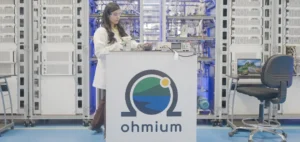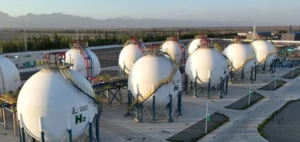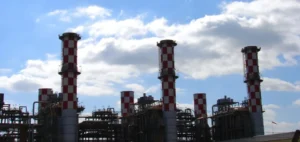It looks like water, “smells like candlelight” and will be used as kerosene for airplanes: in full development, electrofuels are presented as a capital element to decarbonize transportation but require astronomical amounts of green electricity to scale up.
These synthetic fuels, also called electrofuels or e-fuels (PtL for Power to Liquid), are produced by combining hydrogen, produced from decarbonated sources such as renewable or nuclear energy, and carbon dioxide (CO2), captured in the air or, for the moment, in industrial fumes. Their combustion is therefore neutral from a climate point of view, as the CO2 emitted comes from particles that were already in the atmosphere and not from hydrocarbons extracted from the subsoil.
“Basically, e-fuels are liquid electricity,” says Tim Boeltken, CEO of Ineratec. Based in Karlsruhe, this German start-up with 130 employees is at the forefront of this technology with its turnkey electrofuel production units. These factories fit into a simple white container, like those carried by ships. Inside, a whole system of pipes and valves, a first reactor that combines hydrogen and CO2 into a synthesis gas (syngas) and a second one that transforms this gas into liquid fuel. Thirteen units, each with a capacity of one megawatt (MW), can produce up to 350 tons of e-fuel per year.
On Wednesday, the company celebrated the start of construction in Frankfurt of a 10 MW plant, which will initially produce 2,500 tons per year by the beginning of 2024. This one will fit in five containers. There is no need for a huge refinery, “our technology is modular”, explains the 30-year-old manager. “There is not enough green hydrogen and CO2 available today, so a phased approach is competitive,” he believes.
And Ineratec is already planning another 100 MW plant (35,000 tons per year) around 2025-2026. Because the needs are immense, first and foremost for air transport. Sustainable Aviation Fuels (SAF) are the main lever to decarbonize aviation.
Of the loss
The European Union is preparing to impose gradual obligations on airlines to incorporate SAF in kerosene. By 2050, 63% of aviation fuel will have to be sustainable, of which at least 28% will be electrofuels. The French Academy of Technology estimates in a report that Europe will need 30 million tons of e-fuels for air transport by the end of the century, and 400 million tons worldwide.
Ineratec’s shareholders include the aeronautical engine manufacturer Safran, but also the shipowner MPC, the energy company Engie and the car manufacturer Honda, all of which see potential applications. Germany, with its premium cars in the lead, has obtained from the EU that cars with combustion engines can be registered after 2035 if they only use CO2-neutral fuels.
At the risk of a deadly competition with the air industry, which cannot rely on electric motors? Not in the near future, at least,” says Nicolas Jeuland, a sustainable fuels expert at Safran. “The huge auto market can be a good thing for aviation,” he believes. It is about sending “a strong signal” about the need to develop these e-fuels.
And as with hydrocarbon refining, the production of electrofuels results in kerosene (used in aviation), diesel and kerosene, i.e. wax. “We can always make adjustments based on demand, but we will always produce the other types of fuels,” he explains. A major challenge remains: improving energy efficiency. It is only 55%, concedes Tim Boeltken (you have to put 100 units to get 55).
Eventually, “we can reach 80%”, according to him. Most of the energy loss is due to the huge electricity requirement for the electrolysis of water to extract hydrogen.
According to the French Academy of Technology, 37 terawatt-hours of decarbonized electricity, or 8% of French production in 2022, are needed to produce 1 million tons of synthetic kerosene and 670,000 tons of e-diesel. Although the production costs of this synthetic kerosene will eventually come down, it should remain 2.5 times more expensive than traditional kerosene.






















